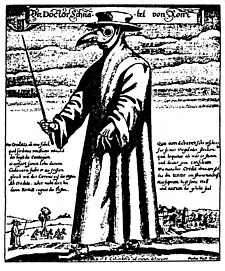What physicians wore when visiting the Plaque Victims.
It was believed that the disease was airborne. So the long beak facial mask was stuffed with herbs to protect the doctor.
The nursery rhyme has a Dark Origin.
The Black Plaque was the cause of it.
The Rhyme dates only back to 1665 with Londons Great Plaque.
What do you know of the Bubonic Plaque?
The Bubonic Plaque has a very Ancient history.
 Amulet picture from Wikipedia Amulet (800 BC – 612 BC) to ward off plague inscribed with a quotation from theAkkadian Erra Epic
Amulet picture from Wikipedia Amulet (800 BC – 612 BC) to ward off plague inscribed with a quotation from theAkkadian Erra Epicfrom Wikipedia:
Antiquity
The earliest account describing a possible plague epidemic is found in I Samuel 5:6 of the Hebrew Bible (Tanakh). In this account, thePhilistines of Ashdod were stricken with a plague for the crime of stealing the Ark of the Covenant from the Children of Israel. These events have been dated to approximately the second half of the 11th century BC.[citation needed] The word "tumors" is used in mostEnglish translations to describe the sores that came upon the Philistines. The Hebrew, however, can be interpreted as "swelling in the secret parts".[citation needed] The account indicates that the Philistine city and its political territory were stricken with a "ravaging of mice" and a plague, bringing death to a large segment of the population.
In the second year of the Peloponnesian War (430 BC), Thucydides described an epidemic disease which was said to have begun inEthiopia, passed through Egypt and Libya, then come to the Greek world. In the Plague of Athens, the city lost possibly one third of its population, including Pericles. Modern historians disagree on whether the plague was a critical factor in the loss of the war. Although this epidemic has long been considered an outbreak of plague, many modern scholars believe that typhus,[13] smallpox, or measles may better fit the surviving descriptions. A recent study of DNA found in the dental pulp of plague victims suggests that typhoid was actually responsible.[14]
In the first century AD, Rufus of Ephesus, a Greek anatomist, refers to an outbreak of plague in Libya, Egypt, and Syria. He records that Alexandrian doctors named Dioscorides and Posidonius described symptoms including acute fever, pain, agitation, and delirium. Buboes—large, hard, and non-suppurating—developed behind the knees, around the elbows, and "in the usual places." The death toll of those infected was very high. Rufus also wrote that similar buboes were reported by a Dionysius Curtus, who may have practiced medicine inAlexandria in the third century BC. If this is correct, the eastern Mediterranean world may have been familiar with bubonic plague at that early date.[15][16]
[edit]Medieval and post-medieval pandemics
Local outbreaks of the plague are grouped into three plague pandemics, whereby the respective start and end dates and the assignment of some outbreaks to either pandemic are still subject to discussion.[17] According to Joseph P. Byrne from Belmont University, the pandemics were:
- the first plague pandemic from 541 to ~750, spreading from Egypt to the Mediterranean (starting with the Plague of Justinian) and northwestern Europe[18]
- the second plague pandemic from ~1345 to ~1840, spreading from Central Asia to the Mediterranean and Europe (starting with theBlack Death), and probably also to China[18]
- the third plague pandemic from 1866 to the 1960s, spreading from China to various places around the world, notably the US-American west coast and India.[19]
- However, the late medieval Black Death is sometimes seen not as the start of the second, but as the end of the first pandemic – in that case, the second pandemic's start would be 1361; also vary the end dates of the second pandemic given in literature, e.g. ~1890 instead of ~1840.[17]
[edit]First Pandemic: Early Middle Ages (Plague of Justinian)
Main article: Plague of JustinianThe Plague of Justinian in AD 541–542 is the first known attack on record, and marks the first firmly recorded pattern of bubonic plague. This disease is thought to have originated in China.[20] It then spread to Africa from where the huge city of Constantinople imported massive amounts of grain, mostly from Egypt, to feed its citizens. The grain ships were the source of contagion for the city, with massive public granaries nurturing the rat and flea population. At its peak the plague was killing 10,000 people in Constantinople every day and ultimately destroyed perhaps 40% of the city's inhabitants. It went on to destroy up to a quarter of the human population of the eastern Mediterranean.In AD 588 a second major wave of plague spread through the Mediterranean into what is now France. It is estimated that the Plague of Justinian killed as many as 100 millionpeople across the world.[21][22] It caused Europe's population to drop by around 50% between 541 and 700.[23] It also may have contributed to the success of the Arab conquests.[24][25] An outbreak of it in the AD 560s was described in AD 790 as causing "swellings in the glands ... in the manner of a nut or date" in the groin "and in other rather delicate places followed by an unbearable fever". While the swellings in this description have been identified by some as buboes, there is some contention as to whether the pandemic should be attributed to the bubonic plague, Yersinia pestis, known in modern times.[26][edit]Second Pandemic: from 14th century (Black Death) to 19th century
See also: Black DeathFrom 1347 to 1351, the Black Death, a massive and deadly pandemic originating in China, spread along the Silk Road and swept through Asia, Europe and Africa.[20] It may have reduced the world's population from 450 million to between 350 and 375 million.[27] Chinalost around half of its population, from around 123 million to around 65 million; Europearound 1/3 of its population, from about 75 million to about 50 million; and Africaapproximately 1/8 of its population, from around 80 million to 70 million (mortality rates tended to be correlated with population density so Africa, being less dense overall, had the lowest death rate). This makes the Black Death the largest death toll from any known non-viral epidemic. Although accurate statistical data does not exist, it is thought that 1.4 million died in England (1/3 of England's 4.2 million people), while an even higher percentage of Italy's population was likely wiped out. On the other hand, Northeastern Germany, Bohemia, Poland and Hungary are believed to have suffered less, and there are no estimates available for Russia or the Balkans. It is conceivable that Russia may not have been as affected due to its very cold climate and large size, hence often less close contact with the contagion.
The plague repeatedly returned to haunt Europe and the Mediterranean throughout the 14th to 17th centuries.[28] According to Biraben, plague was pre1485; 1500–1503; 1518–1531; 1544–1548; 1563–1566; 1573–1588; 1596–1599; 1602–1611; 1623–1640; 1644–1654; and 1664–1667; subsequent outbreaks, though severe, marked the retreat from most of Europe (18th century) and northern Africa (19th century).[30] According to Geoffrey Parker, "France alone lost almost a million people to plague in the epidemic of 1628–31."[31]In England, in the absence of census figures, historians propose a range of preincident population figures from as high as 7 million to as low as 4 million in 1300,[32] and a postincident population figure as low as 2 million.[33] By the end of 1350, the Black Death subsided, but it never really died out in England. Over the next few hundred years, further outbreaks occurred in 1361–62, 1369, 1379–83, 1389–93, and throughout the first half of the 15th century.[34] An outbreak in 1471 took as much as 10–15% of the population, while the death rate of the plague of 1479–80 could have been as high as 20%.[35] The most general outbreaks in Tudor and Stuart England seem to have begun in 1498, 1535, 1543, 1563, 1589, 1603, 1625, and 1636, and ended with the Great Plague of London in 1665.[36]In 1466, perhaps 40,000 people died of plague in Paris.[37] During the 16th and 17th centuries, plague visited Paris for almost one year out of three.[38] The Black Death ravaged Europe for three years before it continued on into Russia, where the disease hit somewhere once every five or six years from 1350 to 1490.[39] Plague epidemics ravaged London in 1563, 1593, 1603, 1625, 1636, and 1665,[40]reducing its population by 10 to 30% during those years.[41] Over 10% of Amsterdam's population died in 1623–1625, and again in 1635–1636, 1655, and 1664.[42] There were 22 outbreaks of plague in Venice between 1361 and 1528.[43] The plague of 1576–1577 killed 50,000 in Venice, almost a third of the population.[44] Late outbreaks in central Europe included the Italian Plague of 1629–1631, which is associated with troop movements during the Thirty Years' War, and the Great Plague of Vienna in 1679. Over 60% of Norway's population died from 1348 to 1350.[45] The last plague outbreak ravaged Oslo in 1654.[46]
In the first half of the 17th century, a plague claimed some 1.7 million victims in Italy, or about 14% of the population.[47] In 1656, the plague killed about half of Naples' 300,000 inhabitants.[48] More than 1.25 million deaths resulted from the extreme incidence of plague in 17th-century Spain.[49] The plague of 1649 probably reduced the population of Seville by half.[50] In 1709–1713, a plague epidemic that followed the Great Northern War (1700–1721, Sweden v. Russia and allies)[51] killed about 100,000 in Sweden,[52] and 300,000 in Prussia.[50] The plague killed two-thirds of the inhabitants of Helsinki,[53] and claimed a third of Stockholm's population.[54] Western Europe's last major epidemic occurred in 1720 in Marseilles,[45] in Central Europe the last major outbreaks happened during the plague during the Great Northern War, and in Eastern Europe during the Russian plague of 1770-1772The Black Death ravaged much of the Islamic world.[55] Plague was present in at least one location in the Islamic world virtually every year between 1500 and 1850.[56] Plague repeatedly struck the cities of North Africa. Algiers lost 30,000–50,000 to it in 1620–21, and again in 1654–57, 1665, 1691, and 1740–42.[57] Plague remained a major event in Ottoman society until the second quarter of the 19th century. Between 1701 and 1750, 37 larger and smaller epidemics were recorded in Constantinople, and 31 between 1751 and 1800.[58]Baghdad has suffered severely from visitations of the plague, and sometimes two-thirds of its population has been wiped out.[59][edit]






No comments:
Post a Comment